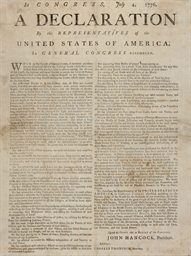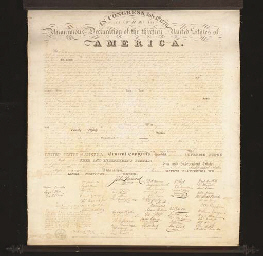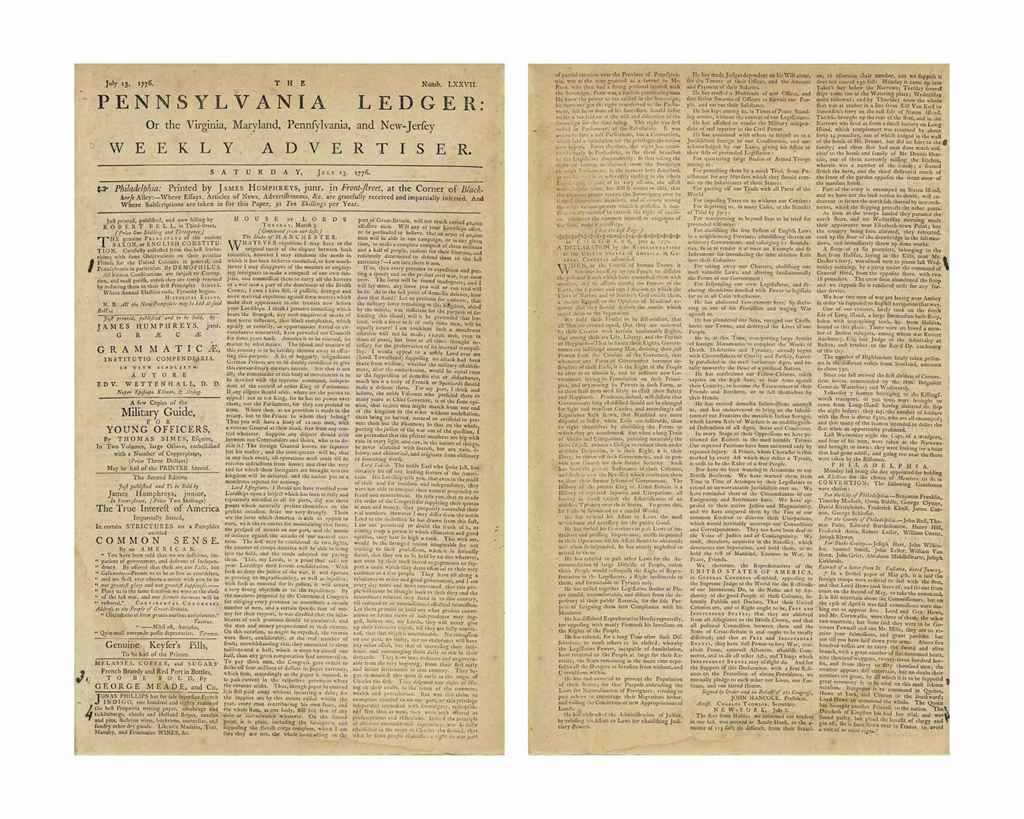DECLARATION OF INDEPENDENCE - EARLY NEWSPAPER PRINTING] The Pennsylvania Journal; and the Weekly Advertiser. Philadelphia: Printed and Sold by William and Thomas Bradford, at the corner of Front and Market-Streets, 10 July, 1776. Folio newspaper retaining deckle edge, housed in a fine custom gilt stamped goatskin case with red watered silk interior. 30 1/4 x 16 1/4 inches (43 x 26 cm); 4 pp., large pictorial vignette in masthead, a manuscript note in a contemporary hand reads "The Declaration of Independence by the Congress in this paper July 4th 1776," the text of the Declaration in the fourth column below the date of the issue and concluding on the first column of the second page. Professional restorations along folds affecting some text and vignette, later ink ownership signature in upper right corner, a few spots in margin. "In CONGRESS, July 4, 1776. A Declaration by the Representatives of the UNITED STATES of AMERICA, in General Congress Assembled. When in the course of human events, it becomes necessary for one people to dissolve the political bands which have connected them with another ... We hold these truths to be self-evident, that all men are created equal, that they are endowed by their creator with certain unalienable rights, that among these are life, liberty and the pursuit of happiness." This issue of William Bradford's The Pennsylvania Journal and Weekly Advertiser, one of the earliest printings of the Declaration of Independence in any form, is possibly the only copy in a private collection, and is held by only eight institutions. This printing is notable as it was published by the revolutionary printer William Bradford who during 1774-75 had been the official printer to the Congress gathered at Philadelphia. Bradford, a serious patriot, had been publishing The Pennsylvania Journal since the 1740s and had printed both the "skull and crossbones" and "tombstone" motifs into his mastheads to protest the Stamp Act in 1765 and also had printed the infamous "Unite or Die" masthead throughout much of 1775. In 1776, as the Congress continued to debate independency in Philadelphia, Bradford switched his masthead from "Unite or Die" to the present, a woodcut figural vignette featuring a Native American, a winged trumpeter, a sailing vessel, and the "Journal" opened on a stand. This vignette is quite evocative of colonial American life in the 18th century, a century dominated by transatlantic voyages, Indian alliances and wars, and of course a slow but increasingly important stream of reliable news. At the outbreak of hostilities, Bradford joined the Pennsylvania militia (at 57 years old) and served throughout much of the war. William Bradford as patriot printer stands in great contrast to the loyalist printer Benjamin Towne, whose thrice-weekly Pennsylvania Evening Post was the first to publish the text of the Declaration in a newspaper on Saturday, July 6th. Throughout the war, Towne's paper flipped loyalties depending on which army possessed Philadelphia, going as far to rename his paper The Royal Pennsylvania Gazette when the British took the city in 1778 (it is no surprise he was eventually arrested for treason). The July 10th Declaration of Independence issue of Bradford's Pennsylvania Journal is scarce. The Saturday, July 6th issue of Towne's Pennsylvania Post is known in 19 copies. John Dunlap printed the text on Monday, July 8th in his Pennsylvania Packet which is known in 12 copies. On July 10th, the same day as the current issue, the text also appeared in Hall & Sellers' Pennsylvania Gazette, which in contrast featured the arms of proprietor William Penn topped by a British lion in its masthead, is known in 17 copies. Thus, the July 10th issue of Bradford's The Pennsylvania Journal, known in only eight institutions and this possibly single privately held example, survives in the least amount of known copies and is genuinely rare (according to Brigham, the institutional count was eight, but a recent exami
DECLARATION OF INDEPENDENCE - EARLY NEWSPAPER PRINTING] The Pennsylvania Journal; and the Weekly Advertiser. Philadelphia: Printed and Sold by William and Thomas Bradford, at the corner of Front and Market-Streets, 10 July, 1776. Folio newspaper retaining deckle edge, housed in a fine custom gilt stamped goatskin case with red watered silk interior. 30 1/4 x 16 1/4 inches (43 x 26 cm); 4 pp., large pictorial vignette in masthead, a manuscript note in a contemporary hand reads "The Declaration of Independence by the Congress in this paper July 4th 1776," the text of the Declaration in the fourth column below the date of the issue and concluding on the first column of the second page. Professional restorations along folds affecting some text and vignette, later ink ownership signature in upper right corner, a few spots in margin. "In CONGRESS, July 4, 1776. A Declaration by the Representatives of the UNITED STATES of AMERICA, in General Congress Assembled. When in the course of human events, it becomes necessary for one people to dissolve the political bands which have connected them with another ... We hold these truths to be self-evident, that all men are created equal, that they are endowed by their creator with certain unalienable rights, that among these are life, liberty and the pursuit of happiness." This issue of William Bradford's The Pennsylvania Journal and Weekly Advertiser, one of the earliest printings of the Declaration of Independence in any form, is possibly the only copy in a private collection, and is held by only eight institutions. This printing is notable as it was published by the revolutionary printer William Bradford who during 1774-75 had been the official printer to the Congress gathered at Philadelphia. Bradford, a serious patriot, had been publishing The Pennsylvania Journal since the 1740s and had printed both the "skull and crossbones" and "tombstone" motifs into his mastheads to protest the Stamp Act in 1765 and also had printed the infamous "Unite or Die" masthead throughout much of 1775. In 1776, as the Congress continued to debate independency in Philadelphia, Bradford switched his masthead from "Unite or Die" to the present, a woodcut figural vignette featuring a Native American, a winged trumpeter, a sailing vessel, and the "Journal" opened on a stand. This vignette is quite evocative of colonial American life in the 18th century, a century dominated by transatlantic voyages, Indian alliances and wars, and of course a slow but increasingly important stream of reliable news. At the outbreak of hostilities, Bradford joined the Pennsylvania militia (at 57 years old) and served throughout much of the war. William Bradford as patriot printer stands in great contrast to the loyalist printer Benjamin Towne, whose thrice-weekly Pennsylvania Evening Post was the first to publish the text of the Declaration in a newspaper on Saturday, July 6th. Throughout the war, Towne's paper flipped loyalties depending on which army possessed Philadelphia, going as far to rename his paper The Royal Pennsylvania Gazette when the British took the city in 1778 (it is no surprise he was eventually arrested for treason). The July 10th Declaration of Independence issue of Bradford's Pennsylvania Journal is scarce. The Saturday, July 6th issue of Towne's Pennsylvania Post is known in 19 copies. John Dunlap printed the text on Monday, July 8th in his Pennsylvania Packet which is known in 12 copies. On July 10th, the same day as the current issue, the text also appeared in Hall & Sellers' Pennsylvania Gazette, which in contrast featured the arms of proprietor William Penn topped by a British lion in its masthead, is known in 17 copies. Thus, the July 10th issue of Bradford's The Pennsylvania Journal, known in only eight institutions and this possibly single privately held example, survives in the least amount of known copies and is genuinely rare (according to Brigham, the institutional count was eight, but a recent exami















Testen Sie LotSearch und seine Premium-Features 7 Tage - ohne Kosten!
Lassen Sie sich automatisch über neue Objekte in kommenden Auktionen benachrichtigen.
Suchauftrag anlegen